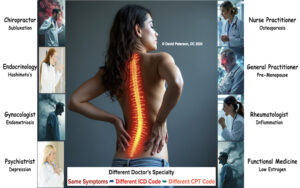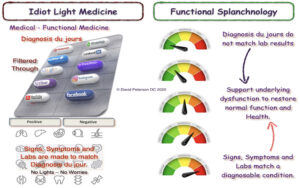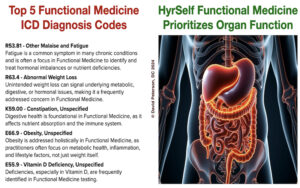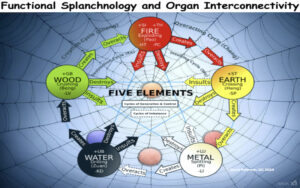Viscerosomatic referred pain is a type of pain that starts in a distressed internal organ but is felt somewhere else in the body. The most well-known example is pain from the heart that radiates to the left arm, shoulder, or jaw, which can be a warning sign of a heart attack. Because heart-related referred pain can signal a life-threatening emergency, it’s taken very seriously by doctors.
However, referred pain isn’t limited to the heart; other distress, dysfunctional organs can also cause discomfort in distant parts of the body. Unfortunately, non-heart-related referred pain often goes unrecognized, which means it can be harder to diagnose and treat correctly. By understanding how referred pain works, @thedrdave at HyrSelf Functional Medicine can better connect symptoms with their true source, helping ensure proper care and avoiding unnecessary treatments.
From One Cell to Misleading Pains: The Embryonic Connection You Never Knew
After fertilization, when the egg and sperm combine, a single cell is formed. This cell begins to divide rapidly, creating more cells that will eventually develop into all the parts of a growing baby. Early on, certain groups of cells start to specialize and split off to form specific organs, like the heart, liver, or kidneys. Interestingly, the cells that will become certain body parts and organs are linked with the cells that form specific areas of skin, muscles, and nerves. These connections are based on where they originally developed from the same group of cells in the fetus.
As a result, the body ends up with a “map” of sorts. If an organ becomes distressed later in life, it can send pain signals to areas of the body that shared its early cells. This is why pain from a struggling organ, like the gallbladder or liver, might show up in unexpected places—such as the shoulder or neck—because these areas originally came from the same cell groups during development. This natural link is what creates “referred pain,” where pain from an organ is felt in seemingly unrelated body parts.
Uncover Hidden Organ Issues: How Pain in Odd Places Could Be a Warning Sign
Imagine you’re starting with a single Lego brick, which represents the fertilized egg. This Lego brick now starts to split into more bricks, and each new brick represents a cell in the developing fetus. Here’s how it goes:
Starting with One:
You have one Lego brick (the fertilized egg).
Splitting Begins:
This brick splits into two, then each of those splits again, doubling every time until you have a whole bunch of bricks (cells).
Specialization:
At first, all these bricks are pretty much the same, like blank canvases. But as they keep dividing, they start to change and specialize. Some will become part of the heart, some the stomach, others the brain, and so on. Each type of brick (cells) starts to take on a role in the body.
Now, here’s where the magic of referred pain comes in:
Shared Origins:
When these cells are dividing early on, some of the cells that will eventually form your organs are right next to or even mixed with the cells that will become nerves, particularly those in the spine.
Neighborhood Development:
Think of it like building houses in a new neighborhood. Some houses (cells) will become organs, and some will be part of the nervous system or spinal cord. They’re all part of the same neighborhood initially, so they’re closely linked.
Nerve Pathways:
As these neighborhoods grow and develop, the nerves that will carry pain signals from these organs are laid down like roads connecting these houses. The nerves that go to your organs often share these ‘roads’ with nerves that go to other parts of your body, especially the back and limbs.
Referred Pain:
Because of this shared origin and close connection, when an organ like your heart or your gut is in distress later in life, the pain signal might take one of these shared pathways and end up causing pain in an area that seems unrelated to the organ itself. It’s like if there’s a fire in one house, the alarm might sound in another house because they’re connected by the same wiring.
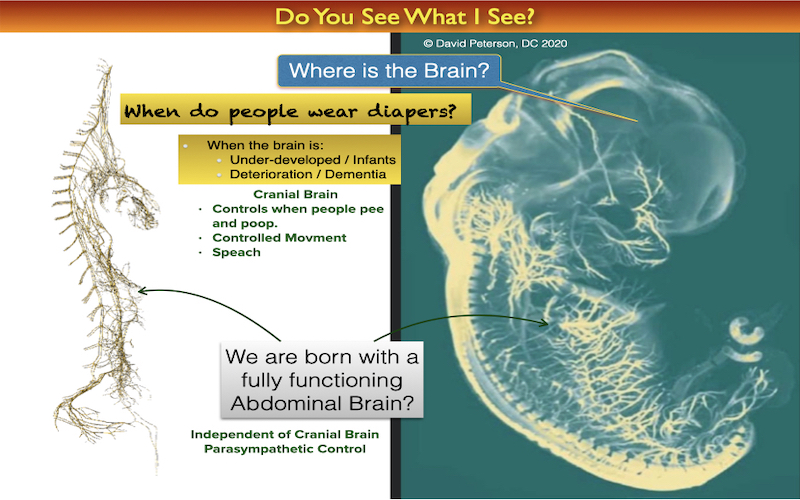
Unraveling the Embryonic Puzzle: The Real Source of Your Phantom Pains
So, in essence, the cells that will become your organs and the cells that will form the areas where you might feel referred pain are siblings from the same early division process. They grow up together, right next to each other, which is why pain can sometimes ‘refer’ or seem to come from a different part of the body than where the actual problem is. It’s a fascinating reminder of how everything in your body is interconnected from the very beginning.
Viscerosomatic referred pain occurs when a problem with a dysfunctional, distressed internal organ creates pain that shows up somewhere else in the body. It happens because the nerves from all the organs of the body are connected to specific areas in the spine, which also link to muscles and tissues in distant regions. When an organ is distressed or dysfunctional, the pain can “refer” to those areas, leading to discomfort in places that may seem unrelated to the actual problem.
These referred pain patterns are based on how nerves link the spine to various organs and body regions. By understanding these connections, @thedrdave at HyrSelf Functional Medicine can more accurately identify and address underlying issues, helping people get the right treatment for the root cause of their pain.
Uncover Hidden Distressed Organ Issues: How Pain in Odd Places Could Be a Warning Sign
Imagine your body as a complex network of roads where all the organs are like cities, and the nerves are the roads connecting these cities. Now, sometimes when there’s trouble in one city (an organ), the alarms (pain signals) don’t just go off in that city alone; they might sound in other cities down the road as well. This is what we call viscerosomatic referred pain.
Here’s how it works for different organs:
- Heart: If your heart is in distress, like during a heart attack, you might feel pain not just in your chest but also in your left arm, neck, or jaw. It’s like the heart’s alarm system is so loud it echoes down these other “roads” or nerves.
- Lungs: Problems here might send pain signals to your shoulder blades or the diaphragm area, making you feel pain in these regions.
- Gallbladder: You could experience pain in your right shoulder or get headaches that start at the back of your head and move over to your right eye.
- Stomach: Pain might show up in your left shoulder, neck, or as a headache in the left temple.
- Pancreas might refer pain to your left shoulder from behind, across your mid-back, or cause headaches in your temples.
- Spleen could make your upper back, left armpit, around your nipple, or even your left groin hurt.
- Liver issues might send pain to your right shoulder from behind, the right side of your neck, or cause headaches in your forehead or eyes.
- Adrenal glands might make your left sartorius muscle (in your leg) or the area around your left kidney hurt.
- Small Intestine pain could radiate from your right shoulder down your back to your left hip and leg, or you might feel it in the front of your abdomen.
- Kidneys could cause low back pain that goes down towards your left hamstring, or you might get plantar fasciitis or pain in the front of your left thigh.
- Ileocecal Valve might result in pain around your right hip or shoulder or down the back of your right leg.
- Cecum or Appendix pain might localize around your right hip or the front of your right shoulder.
- Glandular issues could make parts of your left abdomen hurt or send pain from your upper chest (xyphoid process) to your right hip.
- Colon: Depending on which part (descending, ascending, or transverse), you could feel pain in your thighs, around your collarbones, or even headaches at the top of your head.
- Prostate might cause pain in your hip bones, inner thighs, wrists, the back of your left arm, or inner ankles.
- Uterus could refer pain to your pubic area, both shoulders, left tricep, or cause headaches at the crown of your head.
The Surprising Link Between Organ Dysfunction and Pain in Your Body
This phenomenon happens because:
Shared Nerve Pathways:
The nerves from these organs share the same “roads” or pathways with nerves from other parts of the body. When an organ is in distress, the pain signal can take a wrong turn and end up causing pain somewhere else.
Spinal-Visceral Correlation:
Through the Nervus Vasomotorus, the spine acts like a central station where all these nerve roads converge. Pain from an organ might be felt where these nerves connect to the spine, which then refers the pain elsewhere.
Understanding this can be crucial because:
Misdiagnosis:
Knowing where pain can refer from can prevent misdiagnosis or missing a serious issue.
Early Detection:
Recognizing these patterns might help in seeking early medical attention, especially in life-threatening scenarios like a heart attack.
So, if you ever feel pain in an area that seems unrelated to where you think the problem might be, remember, your body could be giving you a clue that something elsewhere needs attention. It’s like your body’s way of sending a distress signal through the wrong neighborhood, telling you to check on the organ city that’s in trouble.
This referred pain concept is vital because:
Misleading Signals:
It can lead to confusion about where the real problem lies.
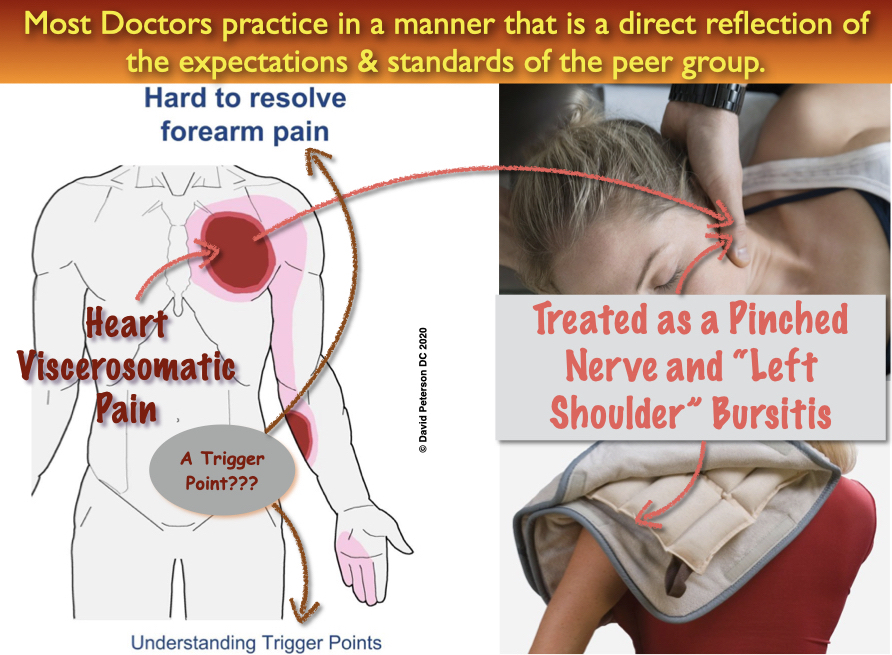
Urgency for Heart Pain:
Especially for heart-related pain, understanding referred pain can be life-saving, as these symptoms might be the only warning sign of a heart attack. In Chiropractic University, I witnessed a Doctor being treated for “Left Shoulder Bursitis” everyday in the clinic with hot packs and electrical stimulation. His appearance was ashen and grey. He was humped over – the body’s way of taking pressure off the heart. One day he was especially ashen in his appearance. I stepped forward, asking the Clinician in charge of his care, if the Doctor was having a heart attack. I was told to mind my F***ing business and get out of the ward. Fortunately the next day, the Doctor survived his heart attack in the clinic the next day.
Summary
In summary, if you feel pain in an area that doesn’t seem directly linked to where you think the issue might be, your body could be signaling distress from a different organ altogether. It’s like your body’s way of shouting for help from a nearby neighborhood because the original one is in trouble.

